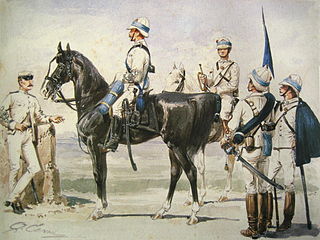
Arditi was the name adopted by a Royal Italian Army elite special force of World War I. Alongside the German Stormtroopers, they were the first modern shock troops, and they have been definied "the most feared corps by opposing armies".

Nobile, traditionally abbreviated to Nob., is an Italian hereditary title borne by a noble who ranks similarly or just below a baron, similar to the rank of Baronet in England or Ritter in Germany. Unlike higher Italian titles which are typically referred to in lieu of an individual's name, nobile is used immediately before the given and surnames, usually in the abbreviated form Nob..
Méhariste is a French word that roughly translates to camel cavalry. The word is most commonly used as a designation of military units.

Savari was the designation given to the regular Libyan cavalry regiments of the Italian colonial army in Tripolitania and Cyrenaica. The word "savari" was derived from a Persian term for "horsemen" (Savārān).

Costanzo Preve was an Italian philosopher and a political theoretician.

Zaptié was the designation given to locally raised gendarmerie units in the Italian colonies of Tripolitania, Cyrenaica, Eritrea and Somaliland between 1889 and 1943.

Dubat was the designation given to members of and the armed irregular bands employed by the Italian "Royal Corps of Colonial Troops" in Italian Somaliland from 1924 to 1941. The word dubat was derived from a Somali phrase meaning "white turban".
Luca Chino Ferrari is an Italian music writer.

The Royal Corps Of Eritrean Colonial Troops were indigenous soldiers from Eritrea, who were enrolled as askaris in the Royal Corps of Colonial Troops of the Royal Italian Army during the period 1889–1941.

The Cacciatori d'Africa were Italian light infantry and mounted infantry units raised for colonial service in Africa. Cacciatori units later served in Somalia, Eritrea, Tripolitania and Cyrenaica for the Italian colonial empire. Partially mechanised in the early 1920s, the Cacciatori d'Africa remained part of the Regio Corpo Truppe Coloniali until 1942.
Italian Spahis were light cavalry colonial troops of the Kingdom of Italy, raised in Italian Libya between 1912 and 1942.

The Royal Corps of Colonial Troops was a corps of the Italian Armed Forces, in which all the Italian colonial troops were grouped until the end of World War II in Africa.

The Royal Corps of Somali Colonial Troops was the colonial body of the Royal Italian Army based in Italian Somaliland, in present-day northeastern, central and southern Somalia.
Marcello Landi (1916-1993) was an Italian painter and poet.
Annibale Ruccello was an Italian playwright, theatre director, and actor.
Pasquale Verrusio was an Italian painter, sculptor and engraver.

Mauro Cardi is an Italian composer.

The Agontano was the currency used by the Italian Maritime Republic of Ancona from the 12th to the 16th centuries during its golden age. It was a large silver coin of 18-22mm in diameter and a weight of 2.04-2.42 grams, of roughly equivalent value to the Milanese Soldo.
Vittorio Gorresio was an Italian Journalist-commentator and essayist.
Luca Poma is an Italian journalist, university professor, writer, and political adviser, having served as an adviser to the Italian Minister of Foreign Affairs Giulio Terzi di Sant'Agata.